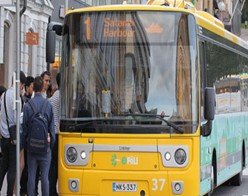- Country: Finland
- Sector: Buses
- Area of Action: Urban transport/Intercity
- Type of service: Municipality/public service
- Power source: Electric
- Aspects described in the case study:
- Decision-making
- Generating awareness among citizens and staff
CONTEXT
Turku is a city in Finland and the regional capital of Southwest Finland. It is located on the southwestern coast of the country at the mouth of the River Aura. The population of Turku is approximately 202,000, while the metropolitan area has a population of approximately 311,000. It is the 6th most populous municipality in Finland, and the third most populous urban area in the country after Helsinki and Tampere.

The introduction of first e-buses was coupled with a research project to study real-world performance and gain more information to be used in fleet expansion.
In 2016, the city of Turku procured a fleet of six fully electric buses along with two opportunity charging stations and depot chargers. The six e-buses electrified the city’s bus route number 1 being the first pilot with fully electric buses in the region.
To assure the performance of the e-bus system and gain information and operational data to be used for future fleet electrification, a separate eFöli research project was started. The main research partner was Turku University of Applied Sciences (Turku UAS) and laboratory tests performed for vehicles were procured from VTT Technical Research Centre of Finland.
Turku UAS made real-world measurements on the chargers and vehicles and analyzed the operational IoT data constantly generated by the various sensors in the buses. The researchers had full access to all data and were able to define key characteristics such as total cost of ownership (TCO); energy consumption on vehicle, charger, and system-level; and nominal emissions. To understand the financial and environmental impact of electrification, a conclusive comparison of TCO and emissions were done between a typical diesel bus and the e-bus system.
Operational data was monitored throughout the project allowing identification of typical charging and discharging profiles. It also helped in troubleshooting the charging problems and other issues faced with the pilot system. To verify the real-world measurements, chassis dynamometer tests were performed at VTT.
THE PROCESS
The project supported the introduction of e-buses and provided publicly available research data on e-bus operation and operational experience. This encouraged private operators to pilot with e-buses. Now number of e-buses has gone up from 6 to 61.

The research also supported drafting of Turku Climate Plan by reassuring that targets of carbon neutral public transport by 2029 and for the city-owner operator already in 2025 are realistic and e-buses should be named as primary mean in the plan.
TEKES – the Finnish Funding Agency for Technology and Innovation funded the project by 240 000 € which covered a major share of the project costs. City of Turku funded Turku UAS by 150 000 € and Turku UAS contributed 64 000 € own funding. Laboratory measurements procured from VTT totaled 97 000 €.
IMPACT
This project demonstrated that coupling the e-bus pilot with a research project and external expertise can make the pilot more fruitful and provide more objective scientific data and more concrete results to be utilized when making plans and decisions on further electrification. This practice can be recommended for all regions first introducing e-buses or when piloting new kinds of e-bus technologies.
The best practice also targets in-house audiences, i.e. results of e-bus transition are also communicated not only to professional staff (of the public transport organisation), but also to managers and officers of the local municipality itself.
MORE INFORMATION
The eFöli project, funded by the City of Turku and TEKES (the Finnish Funding Agency for Innovation) transformed the bus line number 1 of Turku region public transport to operate with electric vehicles. For this purpose, it purchased 6 electric busses which then needed to be powered in an emission-free, relatively noiseless and highly efficient charging environment.
In what could be considered a path-breaking solution for Turku, but a rather straight forward implementation by Heliox, our charging solution comprised DC 50 kW and OC 350 kW. Heliox implemented inverted pantographs as the interface for opportunity charging.
- 97% Efficiency
- Highest Uptime
- Zero Emissions
- Back Office Systems
- Support Services
- Industry’s Quietest
MULTIMEDIA
Source:
https://www.heliox-energy.com/case-studies/leading-pilot-project-for-finnish-city-of-turku
https://www.foli.fi/en/electric-buses
https://www.sustaineurope.com/turku-the-face-of-finlands-future-20210928.html
Videos: CIVITAS ECCENTRIC Turku – Introduction of electric public transport
